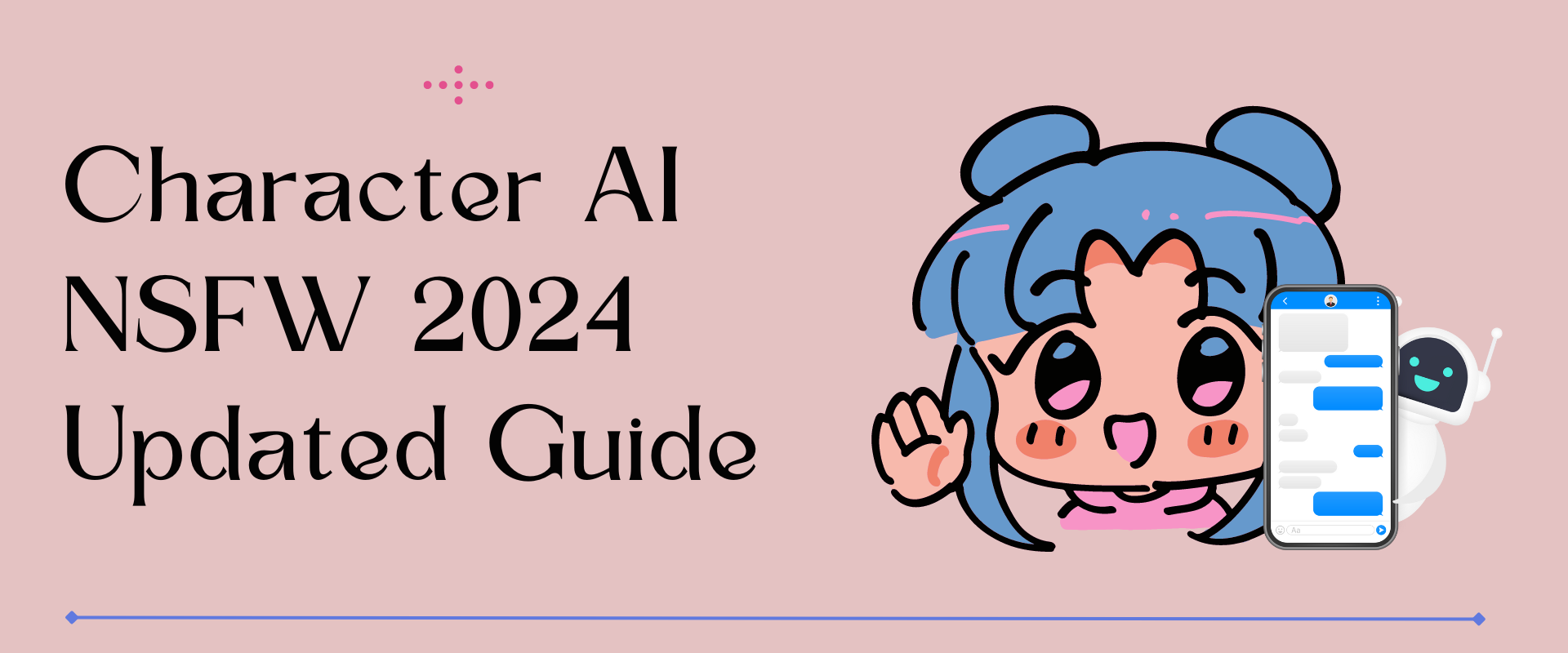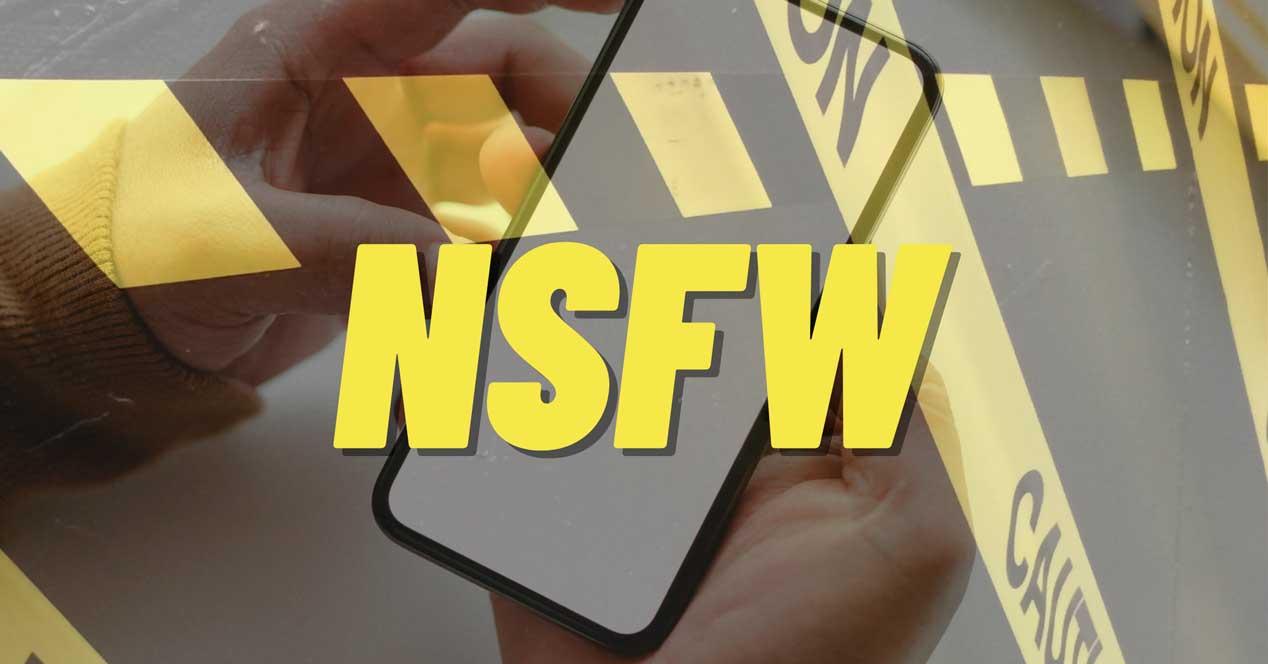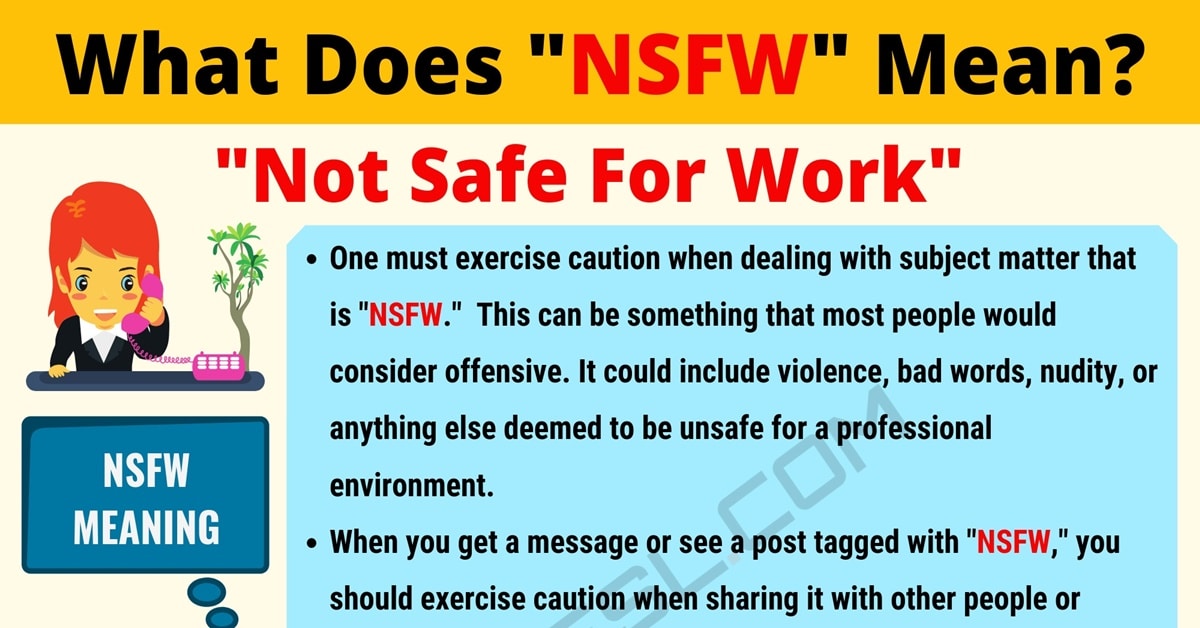Have you ever scrolled through your social feeds, perhaps even on platforms like Twitter, and stumbled upon a link marked with those four little letters: NSFW? It's a pretty common sight, especially these days, and it's there for a very good reason. Essentially, this simple acronym serves as a kind of digital heads-up, letting you know that whatever you're about to open might not be quite right for viewing in just any setting.
You see, what it really comes down to is a quick signal, a little warning, that a particular piece of content – maybe a web page, a video clip, a picture, or even an audio file – carries material that could be considered a bit out of place for certain eyes or ears. While, to be honest, a lot of folks immediately connect it with adult-oriented images or films, the idea behind it is actually much broader. It's about being thoughtful, you know, about what you're seeing and where you're seeing it.
So, we're talking about a quick heads-up that aims to prevent awkward moments or, perhaps, even bigger problems, especially if you happen to be in a spot like your workplace or a public area. This small label, really, tries to give you a moment to think before you click, helping you decide if the content is something you truly want to access right then and there. It's a way, in some respects, to help everyone keep their online experience a little smoother and more considerate.
- Workplace Restraining Order Contra Costa County
- Fatherhood Tattoos
- Odell Beckham Jr Outfits
- Southwest Emotional Support Animal
- Erections In Wrestling
Table of Contents
- What is NSFW, Anyway?
- More Than Just a Warning on NSFW Twitter
- Why Does This Label Matter?
- How Does NSFW Twitter Content Affect Your Day?
- Is NSFW Twitter Always About What You Think?
- The Different Shades of NSFW Twitter
- Who Decides What's NSFW Twitter Content?
- Understanding the Context of NSFW Twitter
What is NSFW, Anyway?
At its heart, NSFW stands for "not safe for work." It's a phrase that, basically, serves as a little heads-up, a quick signal, letting you know that a particular piece of content might not be the best thing to look at when you're at your job or, say, in a public spot where others might see your screen. Think of it as a polite nudge, suggesting you might want to hold off on clicking that link until you're in a more private setting. This simple tag, you know, is all about helping you avoid any uncomfortable situations.
The term itself, as a matter of fact, has been around for quite a while in the digital world, growing out of the early days of internet forums and email chains. It's a shorthand, a quick way to communicate a potential issue without having to spell out every detail. So, when you see it, it's pretty much telling you that whatever is on the other side of that click could be something that might make your boss raise an eyebrow or, perhaps, even get you into a bit of trouble if seen by the wrong person. It's a practical little tool, really, for staying out of hot water.
While a lot of people tend to link NSFW directly with adult material, like explicit images or videos, its meaning can be a bit wider than just that. It's true that much of the content flagged with this warning does fall into that category, but it also covers other types of material that might be considered offensive or just plain unsuitable for a professional environment. For instance, it could be something with very graphic violence, strong language, or, in some respects, even content that's just generally unsettling. It's about being prepared for what you might encounter.
- Christina Sarah Foster
- Kansas City Chiefs Heavy Winter Coats
- Ann Taylor Eva Pants
- Mbti Michelle Obama
- Marshmallow Suit Army
More Than Just a Warning on NSFW Twitter
When we talk about NSFW on platforms like Twitter, it's more than just a simple warning; it's a kind of unspoken agreement among users to be considerate. Twitter, as you know, is a very public space where posts can spread incredibly fast, reaching all sorts of people in different settings. So, a link marked NSFW on Twitter is, basically, a courtesy, a way to say, "Hey, just so you know, this might not be something you want popping up on your screen if you're in an open office or sitting on a bus." It's about respecting the varied environments where people use the platform.
The content itself, whether it's a picture, a short video, or a link to an outside article, gets this special label because it could be seen as inappropriate or, perhaps, even offensive by some. This isn't just about what's against the rules of a workplace; it's also about what might make someone uncomfortable in a public place, like a coffee shop or a library. It's a pretty important little tag, really, especially when you consider how many people scroll through their feeds in all sorts of places throughout their day.
Platforms like Twitter, as a matter of fact, often have their own ways of handling this kind of material, sometimes even blurring images or videos until you actively choose to view them. This is, you know, part of their effort to make the platform a bit safer and more user-friendly for everyone, while still allowing for a wide range of expression. So, when you see that NSFW tag on Twitter, it's not just a random label; it's a signal that helps you make a quick decision about whether to engage with the content right then and there. It's a small but significant part of how we manage our online interactions.
Why Does This Label Matter?
The NSFW label matters a great deal, honestly, because it acts as a very practical safeguard in our daily digital lives. Imagine you're at work, maybe in an open-plan office, and you click on a link that turns out to be something quite explicit or unsettling. That sudden image or sound could, you know, cause a lot of embarrassment, not just for you but for anyone around you. It could even lead to some pretty serious professional consequences, depending on your workplace rules. So, this little tag helps you avoid those awkward, potentially career-damaging moments before they even happen.
Beyond the workplace, this warning is also pretty important for public settings. Think about being on a train, in a waiting room, or even just sitting on a park bench. If you open content that's graphic or adult-oriented without warning, you're not just exposing yourself to it; you're, basically, exposing everyone else who happens to glance at your screen. This can be very disruptive and, in some respects, quite disrespectful to others who might not want to see such material. It's about being a considerate digital citizen, really.
Moreover, the label helps maintain a certain level of comfort and safety for everyone using the internet. Not everyone wants to see explicit or violent content, and having a clear warning allows people to make informed choices about what they consume. It's a way of saying, "Here's what this is, so you can decide if it's for you right now." This is, you know, particularly true for younger audiences or those who might be sensitive to certain types of material. It empowers users to control their viewing experience, which is pretty vital in today's online world.
How Does NSFW Twitter Content Affect Your Day?
NSFW Twitter content, when encountered unexpectedly, can really throw a wrench into your day, or at least your immediate surroundings. Picture this: you're casually scrolling through your Twitter feed during a lunch break at work, maybe even showing a colleague something interesting, and then, bam, a graphic image or a loud, explicit audio clip pops up from a link you clicked. That moment of surprise, and the scramble to close it, can be pretty jarring, you know, and certainly not what you want happening in a professional setting. It affects your focus and, perhaps, your reputation.
The impact isn't just about the immediate shock, either. If you're someone who uses Twitter often for professional networking or keeping up with industry news, accidentally opening NSFW content can make you a bit more hesitant to click on links in the future. This hesitation, in a way, could slow down your information gathering or make you less engaged with your feed, just because you're worried about what might be lurking. It creates a tiny bit of anxiety around what should be a straightforward activity, which is not ideal, honestly.
And then there's the broader social effect. On a platform like Twitter, where content can go viral in moments, a mislabeled or unmarked piece of NSFW material can reach a very wide audience very quickly. This means that many people, not just you, might have their day affected by seeing something they didn't want to see, in a place they didn't expect to see it. It's a reminder that even small labels, like the NSFW tag on Twitter, play a pretty big role in shaping our shared online experience and, you know, keeping things a little more predictable for everyone.
Is NSFW Twitter Always About What You Think?
When you hear "NSFW," your mind might, very naturally, jump straight to pornography or other explicit sexual content. And, to be honest, a good chunk of the material marked with this label does indeed fall into that category. However, it's not always just about that, which is an important point to remember. The definition of "not safe for work" is actually a bit broader, encompassing a range of content that might be deemed unsuitable for public or professional viewing for reasons beyond just sexual explicitness. It's a common misconception, you know, that it's a one-trick pony.
For instance, some content might be flagged NSFW because it contains very graphic violence or gore. This could be images or videos from accidents, crime scenes, or even very intense fictional portrayals that are simply too disturbing for most people to view casually, especially if they're at work or in a public place. While not sexual, such material can be just as, if not more, jarring and inappropriate for certain settings. So, it's not just about what's considered "adult" in a sexual sense, but also what's just plain unsettling or shocking. It's a wider umbrella, basically.
Then there's the category of content that might contain extremely offensive language, hate speech, or deeply disturbing themes that, while not necessarily visual or graphic in the traditional sense, are still highly inappropriate for a professional environment or general public consumption. This type of material, too, can be marked NSFW because it violates social norms or workplace policies, even if it doesn't show anything explicit. So, it's pretty clear that the term covers a lot more ground than just one specific type of content. It's about context and appropriateness, really.
The Different Shades of NSFW Twitter
On a platform like Twitter, the "shades" of NSFW content are, you know, pretty varied. You've got the obvious stuff, like explicit images or videos, which are what most people think of. But then there are also things that might be considered NSFW due to strong language that's just not suitable for a professional ear. Imagine someone's tweet containing a string of very harsh words; that, too, could be seen as not safe for work, especially if your boss is looking over your shoulder. It's about what's acceptable in different social settings, honestly.
Then there are the less obvious examples, like perhaps a link to a news article that, while important, features extremely graphic photos of a disaster or a violent event. While the article itself might be informative, the accompanying visuals could be very disturbing and, in some respects, certainly not something you'd want displayed on your screen in an open office. So, on NSFW Twitter, it's not just about what's intentionally provocative; it's also about content that's simply too intense or upsetting for general viewing, even if it has a legitimate context.
Moreover, the concept of what makes something "not safe for work" can be a bit personal, too. What one person finds mildly inappropriate, another might find extremely offensive. This subjective element means that content creators on Twitter sometimes err on the side of caution, marking something NSFW even if it's borderline, just to be safe. This creates a kind of spectrum of "not safe," ranging from mildly questionable to extremely explicit. It's a system that, you know, tries to cater to a wide range of sensitivities and workplace policies, making it a bit complex but ultimately helpful.
Who Decides What's NSFW Twitter Content?
This is a pretty interesting question, honestly, because there isn't one single authority that decides what counts as NSFW content, especially on a vast platform like Twitter. A lot of it comes down to a mix of things: platform rules, community standards, and, very importantly, individual judgment. Twitter, for example, has its own set of guidelines about what kind of content is allowed and what needs to be flagged or, perhaps, even removed. These rules are a big part of what shapes the general understanding of NSFW on their site. So, the platform itself plays a significant role in setting the tone.
Beyond the official rules, there's also the influence of the user community. People often report content they believe is inappropriate, and these reports help Twitter's moderation teams identify and label material. Moreover, individual users often decide for themselves what they consider NSFW before they post it. If someone thinks a picture or video they're about to share might cause problems for others in a work or public setting, they'll, basically, add that warning label themselves. It's a kind of self-policing system, in a way, that relies heavily on user discretion.
Then there's the subjective element, which is pretty significant. What's considered "not safe for work" can vary a lot from one workplace to another, or even from one culture to another. A company with a very strict policy might consider certain images or jokes to be NSFW, while another, more relaxed environment might not. This means that the label, ultimately, is a broad warning that aims to cover a wide range of sensitivities and rules. It's not a perfect system, but it's the best way, you know, to give users a heads-up in a very diverse online world.
Understanding the Context of NSFW Twitter
Understanding the context of NSFW Twitter content is, you know, pretty vital because the meaning of "not safe for work" can shift depending on where and why you're looking at something. For example, a piece of art that might be considered explicit in a corporate office could be perfectly acceptable, even celebrated, in an art gallery or on a personal Twitter account dedicated to artistic expression. The setting, basically, changes everything about whether something is appropriate or not. It's not just about the content itself, but also the environment in which it's viewed.
Consider also the purpose behind the content. A medical image, while potentially graphic, is not NSFW if you're a doctor looking at it as part of your job. However, if that same image pops up on your Twitter feed while you're sitting in a crowded coffee shop, it would definitely be considered NSFW. So, the intention of the creator and the reason for viewing the content both play a big part in its classification. It's about being mindful, really, of the different hats we wear throughout our day and how that affects what we can openly consume.
Twitter, being a global platform, also means that cultural context comes into play. What might be completely normal or even mundane in one country could be considered highly offensive or explicit in another. This makes the NSFW label a very useful, albeit broad, tool for creators to signal potential issues across diverse audiences. It's a way to say, "Hey, this might not be for everyone, everywhere." So, when you see that warning on Twitter, remember that it's a call to consider your surroundings and, in some respects, the wider world before you click. It's about being thoughtful, basically, in a very connected space.
Related Resources:



Detail Author:
- Name : Marlene Gottlieb
- Username : carter.eloy
- Email : uframi@yahoo.com
- Birthdate : 1986-12-31
- Address : 362 Darwin Square East Cletus, AZ 58253-6136
- Phone : +1-864-446-9012
- Company : Hilpert LLC
- Job : Food Preparation
- Bio : Odio autem totam repellendus quibusdam aut. Corrupti nihil asperiores quaerat vero at. Omnis inventore ex repudiandae eos aut aut. Ad vel asperiores a est laborum maiores amet.
Socials
tiktok:
- url : https://tiktok.com/@buckridged
- username : buckridged
- bio : Adipisci sequi porro esse est soluta ullam. Quasi velit eligendi non nisi.
- followers : 362
- following : 1994
instagram:
- url : https://instagram.com/dereck3522
- username : dereck3522
- bio : Eius quo natus sint nobis. Ea eos voluptatum labore et.
- followers : 5195
- following : 669